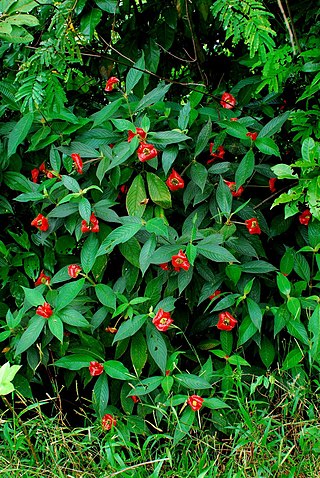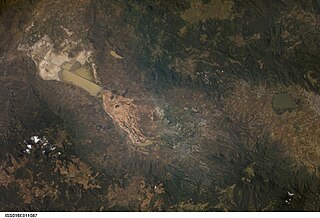
Psychotria is a genus of flowering plants in the family Rubiaceae. It contains 1,582 species and is therefore one of the largest genera of flowering plants. The genus has a pantropical distribution and members of the genus are small understorey trees in tropical forests. Some species are endangered or facing extinction due to deforestation, especially species of central Africa and the Pacific.

Xylophanes crotonis is a moth of the family Sphingidae first described by Francis Walker in 1870.

Palicourea is a genus of flowering plants in the family Rubiaceae. It contains 694 species, which range from shrubs to small trees, and is distributed throughout the New World tropics.
Palicourea asplundii is a species of plant in the family Rubiaceae. It is endemic to Ecuador.
Palicourea azurea is a species of plant in the family Rubiaceae. It is endemic to Ecuador.
Palicourea calantha is a species of plant in the family Rubiaceae. It is endemic to Ecuador.
Palicourea candida is a species of plant in the family Rubiaceae. It is endemic to Ecuador.
Palicourea corniculata is a species of plant in the family Rubiaceae. It is endemic to Ecuador.
Palicourea fuchsioides is a species of plant in the family Rubiaceae. It is endemic to Ecuador.
Palicourea heilbornii is a species of plant in the family Rubiaceae. It is endemic to Ecuador.
Palicourea herrerae is a species of plant in the family Rubiaceae. It is endemic to Peru.
Palicourea latifolia is a species of plant in the family Rubiaceae. It is endemic to Peru.
Palicourea lobbii is a species of plant in the family Rubiaceae. It is endemic to Ecuador.
Palicourea sodiroi is a species of plant in the family Rubiaceae. It is a shrub and grows primarily in wet tropical habitats. It is endemic to Ecuador.
Palicourea microcarpa, synonym Rudgea microcarpa, is a species of plant in the family Rubiaceae. It is native to Bolivia and Peru.

Palicourea tomentosa, many synonyms, including Psychotria poeppigiana, is a plant species in the family Rubiaceae. A common name is sore-mouth bush, though it is not very often used.

Laguna de Sayula is a lake located in the southern area of Jalisco, about 60 km from Guadalajara. It is located in the municipalities of Sayula, Zacoalco de Torres, Amacueca, Teocuitatlán de Corona, Atoyac and Techaluta de Montenegro.
Palicoureeae is a tribe of flowering plants in the family Rubiaceae and contains about 817 species in 11 genera. Its representatives are found in the tropics and subtropics.

Dr. Charlotte M. Taylor is a botanist and professor specialising in taxonomy and conservation. She works with the large plant family Rubiaceae, particularly found in the American tropics and in the tribes Palicoureeae and Psychotrieae. This plant family is an economically important group, as it includes plant species used to make coffee and quinine. Taylor also conducts work related to the floristics of Rubiaceae and morphological radiations of the group. Taylor has collected plant samples from many countries across the globe, including Chile, Colombia, Costa Rica, Panama, and the United States of America, and has named many new species known to science from these regions. As of 2015, Taylor has authored 278 land plant species' names, the seventh-highest number of such names authored by any female scientist.

Palicourea elata, formerly Psychotria elata, commonly known as girlfriend kiss and labios de puta, is a tropical plant that ranges from Central to South American rain forests in countries such as Mexico, Costa Rica, Ecuador, Panama, and Colombia. Palicourea elata is extremely sensitive and requires specific climates to grow, those climates most like rainforests are best suitable for this plant. It is most notable for its distinctly shaped red bracts and is consequently nicknamed “Hot Lips”. Though the bright red bracts are considered its most flashy feature, they are not the actual flowers of the plant but instead extravagant leaves; the flowers of Palicourea elata lie within the “red lip” leaves. Just like human lips, the hot lips plant comes in a variety of shapes and forms offering a vast array of plants. P. elata is well-studied and has been documented over centuries to provide various health benefits to native communities. Due to these benefits and the overall appearance of the plant, it has been over-harvested and is now endangered.







